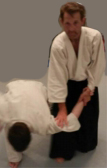| Aikido |
The word "Aikido" is made up of three Japanese characters: "Ai" – join or harmony, "Ki" - spirit or universal energy, "Do" - the Way. Thus Aikido is "the Way of Harmony with Universal Energy."
|
| Ai Hanmi |
Paired stance where UKE and NAGE each have the same foot forward.
|
| Ashi Sabaki |
Footwork. ("Tsugi Ashi"= slide, "Ayumi Ashi"=step)
|
| Atemi |
Strike directed at the attacker for purposes of unbalancing or distraction
|
| Budo |
Martial Way
|
| Chushin |
Center, especially, the center of one's movement or balance
|
| Dan |
Black belt rank
|
| Do |
Way/path. The Japanese character for "DO" is the same as the Chinese character for Tao (as in "Taoism").
|
| Dojo |
Literally "place of the Way". Where we practice Aikido.
|
| Domo Arigato Gozaimashita |
Japanese for "Thank you very much". At the end of each class, it is proper to bow and thank the instructor and those with whom you've trained.
|
| Doshu |
Head of the Way (currently Moriteru Ueshiba, grandson of Aikido's founder, Morihei Ueshiba)
|
| Gi/Dogi/Keiko Gi |
Training uniform
|
| Gyaku Hanmi |
Paired stance where UKE and NAGE have the opposite foot forward
|
| Hanmi |
Triangular stance
|
| Hombu Dojo |
A term used to refer to the central dojo of an organization. This usually designates Aikido World Headquarters in Tokyo.
|
| Hidari |
Left
|
| Irimi |
Entering movemen
|
| Kaiso |
The Founder of Aikido, Morihei Ueshiba, also called "O Sensei"
|
| Kamae |
A posture or stance. Although "Kamae" generally refers to a physical stance, there is an important parallel in Aikido between one's physical and one's psychological bearing.
|
| Kamiza |
A small shrine, especially in an Aikido, generally located in the front of the dojo. One bows in the direction of the "Kamiza" when entering or leaving the dojo, or the mat.
|
| Kata |
A "form" or prescribed pattern of movement. Also “shoulder”.
|
| Keiko |
Training. The literal translation of the characters is “to study the old”.
|
| Ki |
Mind. Spirit. Energy. Vital-force. Intention. (Chinese = chi.)
|
| Kohai |
A student junior to oneself
|
| Kokoro |
"Heart or mind"
|
| Kokyu |
Breath
|
| Kuzushi |
The principle of destroying one's partner's balance. In Aikido, a technique cannot be properly applied unless one first unbalances one's partner.
|
| Kyu |
White belt rank. (Or any rank below "Shodan")
|
| Ma Ai |
Proper distancing or timing with respect to one's partner
|
| Mae |
Front, as in "Mae Ukemi" or falling forward
|
| Migi |
Right
|
| Mokuso |
Meditation. Practice often begins or ends with a brief period of meditation. The purpose of meditation is to clear one's mind and to develop cognitive equanimity.
|
| Nage |
The thrower, also "Tori"
|
| Obi |
A belt
|
| Omote |
"The front", entering to the front
|
| Onegai shimasu |
"I welcome you to train with me," or literally, "I make a request." This is said to one's partner when initiating practice.
|
| O-Sensei |
Literally, "Great Teacher", i.e., Morihei Ueshiba, the Founder of Aikido
|
|
|
|
| Reigi |
Etiquette. Observance of proper etiquette is as much a part of one's training as the practice of techniques. Observation of etiquette indicates one's sincerety, one's willingness to learn, and one's recognition of the rights and interests of others. Also "Reigi Saho".
|
| Sensei |
Teacher. It is usually considered proper to address the instructor during practice as "Sensei" rather than by is/her name. If the instructor is a permanent instructor for one's DOJO or for an organization, it is proper to address him/her as "Sensei" off the mat as well.
|
| Seiza |
Sitting on one's knees
|
|
|
|
| Sempai |
A student senior to oneself
|
| Shikko |
Knee walking
|
| Shodan |
First degree black belt
|
| Shomen |
Front or top (of head), also the designated front of a "Dojo"
|
| Soto |
Outside
|
| Tai Sabaki |
Body movement
|
| Taninsugake |
Training against multiple attackers
|
| Tegatana |
"Hand sword", i.e. the edge of the hand
|
| Tenkan |
Turning movement (see "Tai No Tenkan")
|
| Tenshin |
A movement where "nage" moves 45 degrees away from the attack
|
| Uchi |
"Inside", also “strike”
|
| Ueshiba Kisshomaru |
The son of the Founder of Aikido and second Aikido "Doshu"
|
| Ueshiba Morihei |
The Founder of Aikido (see "O Sensei and "Kaiso")
|
| Ueshiba Moriteru |
The grandson of the Founder and current "Dojoshu"
|
|
|
|
| Uke |
Person being thrown (receiving the technique)
|
| Ukemi |
Literally "receiving [with/through] the body", thus, the art of falling in response to a technique. The development of proper ukemi skills is just as important as the development of throwing skills and is no less deserving of attention and effort.
|
|
|
|
| Ura |
Rear
|
|
|
|
| Ushiro |
Backwards or behind, as in "Ushiro ukemi" or falling backwards
|
| Waza |
Technique
|
| Yudansha |
Black belt holder
|
| Zanshin |
Lit. "remaining mind/heart". Even after an Aikido technique has been completed, one should remain in a balanced and aware state. |

